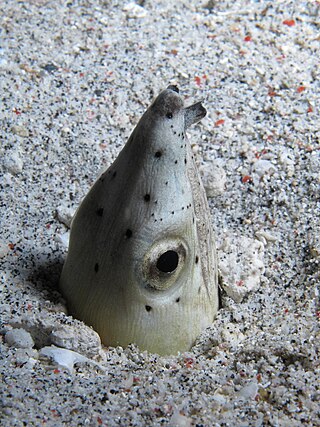
The ribbon eel, also known as the leaf-nosed moray eel or bernis eel, is a species of moray eel, the only member of the genus Rhinomuraena. The ribbon eel is found in sand burrows and reefs in the Indo-Pacific Ocean. Although generally placed in the moray eel family Muraenidae, it has several distinctive features leading some to place it in its own family, Rhinomuraenidae.

Ophichthidae is a family of fish in the order Anguilliformes, commonly known as the snake eels. The term "Ophichthidae" comes from Greek ophis ("serpent") and ichthys ("fish"). Snake eels are also burrowing eels. They are named for their physical appearance, as they have long, cylindrical, snake-like bodies. This family is found worldwide in tropical to warm temperate waters. They inhabit a wide range of habitats, from coastal shallows and even rivers, to depths below 800 m (2,600 ft). Most species are bottom dwellers, hiding in mud or sand to capture their prey of crustaceans and small fish, but some are pelagic.

The New Zealand longfin eel, also known as ōrea, is a species of freshwater eel that is endemic to New Zealand. It is the largest freshwater eel in New Zealand and the only endemic species – the other eels found in New Zealand are the native shortfin eel, also found in Australia, and the naturally introduced Australian longfin eel. Longfin eels are long-lived, migrating to the Pacific Ocean near Tonga to breed at the end of their lives. They are good climbers as juveniles and so are found in streams and lakes a long way inland. An important traditional food source for Māori, who name them ōrea, longfin eel numbers are declining and they are classified as endangered, but over one hundred tonnes are still commercially fished each year.

Monopenchelys acuta, the redface moray or redface eel, is a species of saltwater eel, the only member of the genus Monopenchelys of the Muraenidae family. It is found in the Atlantic, the eastern Pacific, and the western Indian Ocean. Its length is up to 209 mm (8.2 in).

Jellied eels is a traditional English dish that originated in the 18th century, primarily in the East End of London. The dish consists of chopped eels boiled in a spiced stock that is allowed to cool and set, forming a jelly. It is usually served cold.

Eels are ray-finned fish belonging to the order Anguilliformes, which consists of eight suborders, 20 families, 164 genera, and about 1000 species. Eels undergo considerable development from the early larval stage to the eventual adult stage and are usually predators.

Mastacembelus ellipsifer is a species of spiny eel that is endemic to Lake Tanganyika in Africa and sometimes kept in aquariums. Although sometimes called the Tanganyikan spiny eel, it is only one of fifteen spiny eel species in the Tanganyikan basin.
Neoconger is a genus of eels of marine ray-finned fishes belonging to the family Moringuidae, the spaghetti eels. These eels occur in shallow tropical and subtropical waters.

Scolecenchelys is a genus of eels in the snake eel family Ophichthidae.

Protanguilla palau is a species of eel, the only species in the genus Protanguilla, which is in turn the only genus in its family, Protanguillidae. Its common name is Palauan primitive cave eel. Individuals were found swimming in March 2010 in a deep underwater cave in a fringing reef off the coast of Palau.

Eels are elongated fish, ranging in length from five centimetres (2 in) to four metres (13 ft). Adults range in weight from 30 grams to over 25 kilograms. They possess no pelvic fins, and many species also lack pectoral fins. The dorsal and anal fins are fused with the caudal or tail fin, forming a single ribbon running along much of the length of the animal. Most eels live in the shallow waters of the ocean and burrow into sand, mud, or amongst rocks. A majority of eel species are nocturnal and thus are rarely seen. Sometimes, they are seen living together in holes, or "eel pits". Some species of eels live in deeper water on the continental shelves and over the slopes deep as 4,000 metres (13,000 ft). Only members of the family Anguillidae regularly inhabit fresh water, but they too return to the sea to breed.
The smalleye spaghetti-eel is an eel in the family Moringuidae. It was described by Charles Henry Gilbert in 1890. It is a tropical, marine eel known from the eastern central and southeastern Pacific Ocean, including Mexico, Colombia, Costa Rica, El Salvador, Guatemala, Honduras, Nicaragua, and Panama. It is known to dwell at an approximate depth of 55 m, and inhabits substrates, burrowing into mud and sand. Its diet consists primarily of shrimp, crabs, benthic gastropods, bivalves, and worms.
The white-ring garden eel, also known as the Cape garden eel in Mexico, is an eel in the family Congridae. It was described by Garry I. McTaggart-Cowan and Richard Heinrich Rosenblatt in 1974, originally under the genus Taenioconger. It is a marine, tropical eel which is known from the Gulf of California, in the eastern central Pacific Ocean. It is known to dwell at a depth of 20 m (66 ft), and inhabits sand sediments near reefs, where it forms burrows in nonmigratory colonies. Males can reach a maximum total length of 80 cm.
Scolecenchelys chilensis is an eel in the family Ophichthidae. It was described by John E. McCosker in 1970, originally under the genus Muraenichthys. It is a marine, subtropical eel which is known from Desventuradas Island and Juan Fernández Island, in the southeastern Pacific Ocean. It inhabits sand and debris found in between crevices and rocks. Males can reach a maximum standard length of 28.4 centimetres (11.2 in).
Scolecenchelys vermiformis is an eel in the family Ophichthidae. It was described by Wilhelm Peters in 1866, originally under the genus Chilorhinus. It is a marine, tropical eel which is known from Sri Lanka, in the western Indian Ocean.

The highfin snake eel (Ophichthus altipennis, also known as the blackfin snake eel or the black-finned snake eel, is an eel in the family Ophichthidae. It was described by Johann Jakob Kaup in 1856, originally under the genus Microdonophis. It is a marine, tropical eel known from the eastern Indian Ocean and northwestern and western central Pacific Ocean, including Australia, French Polynesia, Indonesia, Japan, the Marshall Islands, Malaysia, the Philippines, and Papua New Guinea. It dwells at a depth range of 0 to 40 m, and forms burrows in soft inshore sand sediments. Males can reach a maximum total length of 103 cm.

The rice-paddy eel is an eel in the family Ophichthidae. It was described by Francis Buchanan-Hamilton in 1822, originally in the genus Ophisurus. It is a tropical, marine eel which is known from the Indo-West Pacific, including Somalia, Tanzania, South Africa, India, Pakistan, Sri Lanka, Indonesia, Polynesia, Australia, Bangladesh, Cambodia, Kenya, Madagascar, the Philippines, Malaysia, Mozambique, Seychelles, Saudi Arabia, Taiwan, China, Thailand, Vietnam, and southern Yemen. It is an anadromous species and spawns in freshwater, often in rice paddies during the rainy season, earning it its common name. It also spends time in lagoons, estuaries and coastal rivers, in which it lives in burrows in the river bottom and bank. Males can reach a maximum total length (TL) of 100 centimetres, but more commonly reach a TL of 70 cm.

Kyeintali is a town located in Gwa Township of Rakhine State, Myanmar (Burma).

Vermicella vermiformis, commonly known as the Centralian bandy-bandy, is a species of snake in the family Elapidae.
Tantilla vermiformis, Hallowell's centipede snake, is a species of snake of the family Colubridae.














